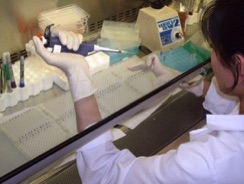

Precision Functional Cancer Profiling Services Personalized for You
One way to achieve major improvements in cancer chemotherapy is to discover new drugs and indeed many are on the horizon. However, this doesn’t help the cancer patient who needs treatment now. Fortunately, many good chemotherapy drugs already exist. The way to improve chemotherapy outcomes immediately - not years from now - is to use existing drugs more effectively. That is where Precision Functional Cancer Profiling comes in. Dr. Weisenthal and the Weisenthal Cancer Group are dedicated to matching each patient with the treatment that offers the best chance for success.
Dr. Weisenthal tests for anti-tumor (cancer cell killing) activity in an extensive range of cancer treatments in the following classes:
● Standard cytotoxic drugs
● Kinase-targeted agents
● Immunologic agents
● Anti-angiogenic agents
● Integrative agents
Dr. Weisenthal personally designs a broad, individualized panel of drugs to be tested for each patient. He tests the drugs as single agents and also in rational drug combinations to identify possible drug synergies. If physicians or patients have their own drug requests, these will also be tested.
Useful, Accurate, Comprehensive Test Data
The tests will show if each drug and drug combination is highly effective, somewhat effective, or not effective at all in killing the patient’s own living cancer cells. In most cases the tests will identify several drugs that fall into each category.
In addition to the qualitative drug assessment described above, Dr. Weisenthal provides a quantitative likelihood of actual patient benefit from each agent. This is expressed as a numerical "probabllilty of respose." It is derived from a statistical algorithm that takes into account cell killing activity observed in vitro, each patient’s diagnosis and treatment history, and comparison with an index database derived from thousands of previous closely matched patient assays Dr. Weisenthal has performed with that agent.
Dr. Weisenthal personally determines the affect of each drug, tested at two different concentrations, upon the tumor cells. This involves examining dozens of microscope slides, including positive and negative controls, and interpreting, scoring, and characterizing tens of thousands of individual cancer cells. It is a highly laborious process and typically requires 8 to 10 full-time hours of his time and expertise.
Dr. Weisenthal then calculates results and prepares his report. Dr. Weisenthal’s cytometric profiling report includes his written interpretation of the test data and a personalized treatment recommendation.
Dr. Weisenthal’s test results identify the best chemotherapy treatment for each patient while ruling out drugs that have extremely low probability of providing benefit. Unlike so-called “standard of practice” treatments, which are generalized for the mythical “average cancer patient,” cytometric profiling-guided treatments are based upon objective laboratory evidence of their effectiveness specifically against each patient’s own living cancer cells.
Rigorous Testing Methods Enhance Predictive Accuracy
Tissues are dissociated and tumor cells are extracted but not purified or isolated. Instead they are conserved as cell micro-aggregates. In addition to cancer cells, these micro-aggregates also contain effector cells, endothelial cells, and other constituents in order to allow for cell to cell signaling and other important biologic interactions. It is important to note that we do not expand the cell population in vitro - the cells are not “grown” in culture - as this would likely give rise to genetic changes in the cell population and thereby render test results unreliable.
Unlike other labs, Dr. Weisenthal tests each patient’s living cancer cells in parallel in multiple assay systems. This enhances the accuracy and reliability of the test results.
The principal testing system used is the Weisenthal DiSC (differential staining cytotoxicity) Assay. This assay was originated by Dr. Weisenthal while he was a clinical and research associate at the National Cancer Institute. Dr. Weisenthal is recognized as a leader in this field and his test is regarded as the gold standard by physicians and researchers worldwide.
In Dr. Weisenthal’s test the patient’s cancer cells are cytocentrifuged onto permanent glass microscope slides after being exposed individually to a broad range of anti-cancer agents. The cells are differentially stained to allow for discrimination of normal versus neoplastic cells and living versus dead cells.
Dr. Weisenthal’s DiSC assay was the first live tumor cell profiling method to feature an apoptotic, cell death endpoint. This endpoint is one of many ways in which Dr. Weisenthal’s approach is a vast improvement over earlier testing methods. A better understanding today of the role of apoptosis in tumorigenesis and cancer treatment has inspired an enhanced appreciation of the advantages of Dr. Weisenthal’s approach. However, some physicians still confuse Dr. Weisenthal’s test with earlier, less reliable methods or they simply are not aware of the critical differences.
In addition to the DiSC assay, Dr. Weisenthal tests each drug in parallel in the MTT [3-(4,5-dimethylthiazol-2-yl)-2,5-diphenyl tetrazolium bromide] assay and also in the ATP (Adenosine Triphosphate) assay, and/or the Alamar Blue assay. All of these methodologies utilize Dr. Weisenthal’s cell death assay endpoint. Use of multiple cell-death methodologies enhances the accuracy of results by allowing for comparative analysis of data obtained from different but highly complementary assay systems.
It should be noted that the tests do not seek to re-create precisely the full range of human biology in a test tube or Petri dish. That would be impossible. Instead, Dr. Weisenthal rigorously calibrates each agent he tests with respect to concentration, exposure time, cell plating densities, activity cut-offs, and many other factors. His strict methods account for the thousands of uniformly positive clinical correlations and high levels of predicive accuracy reported in more than 150 peer-reviewed studies.

SERVICES